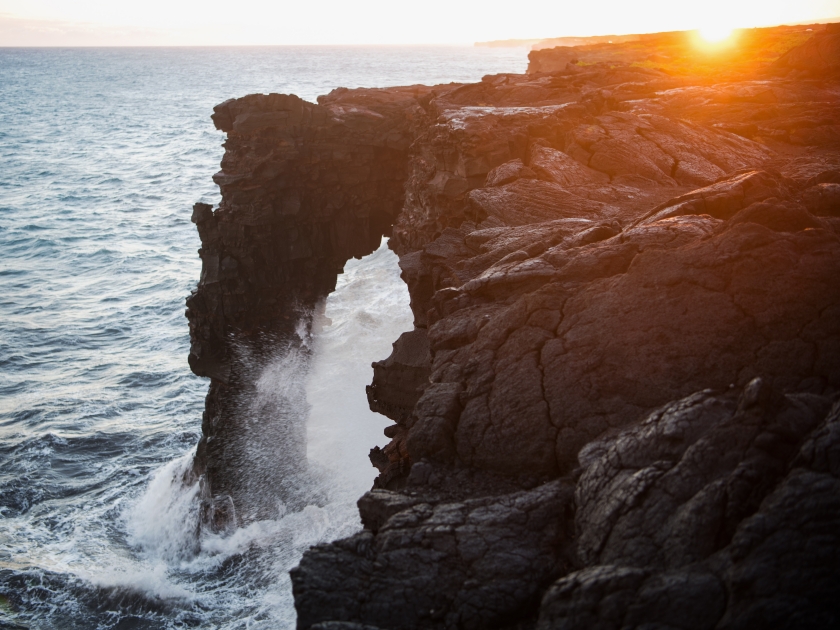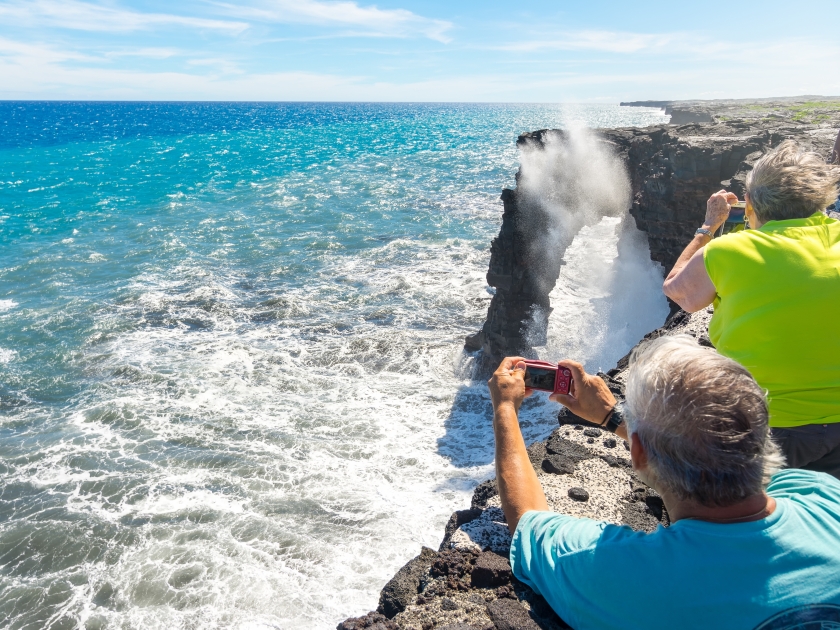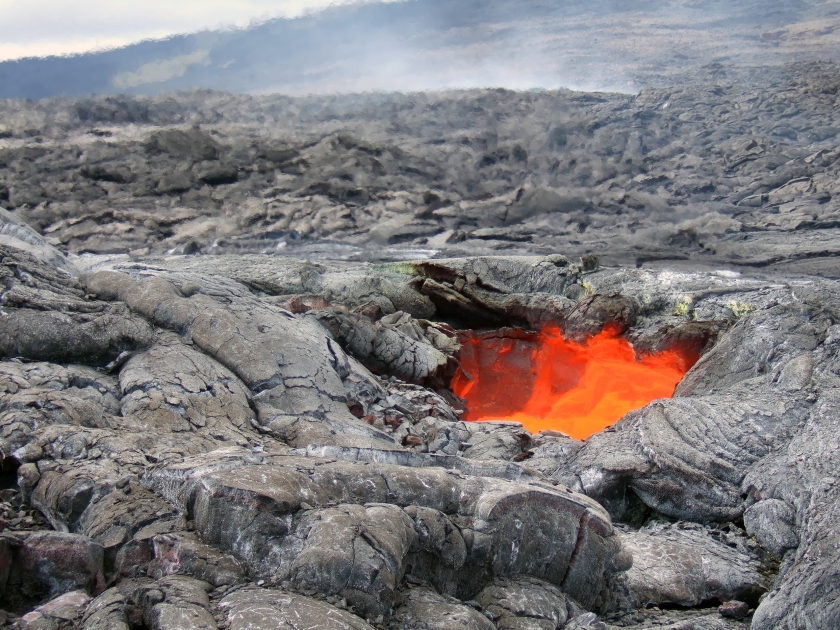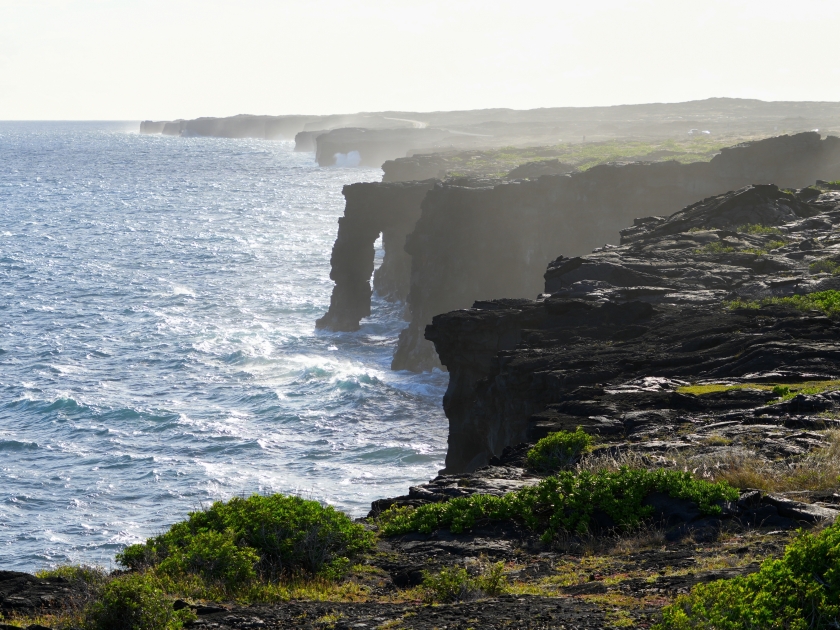The Holei Sea Arch is a stunning natural formation located within the Hawaii Volcanoes National Park on the Big Island of Hawaii. This impressive arch, carved by the relentless force of ocean waves against volcanic rock, stands as a testament to the island’s dynamic geological processes. Towering over 90 feet tall, the Holei Sea Arch offers visitors breathtaking views of the Pacific Ocean and a unique glimpse into the island’s volcanic history. This article serves as a comprehensive travel guide, providing essential information for planning a visit, including directions, the best times to visit, nearby attractions, and practical tips to ensure a memorable experience.
Highlights
- The dramatic scenery and unique formation make it a prime spot for photography. The contrast between the black volcanic rock and the blue ocean is particularly striking at sunrise and sunset.
- Interpretive signs and park rangers are often available to provide educational information about the formation of the arch, volcanic activity, and the park’s natural history.
- The sea arch is easily accessible via a short, well-maintained trail from the end of Chain of Craters Road, making it suitable for visitors of all ages and fitness levels.
- Combine their trip with explorations of lava tubes, active volcanoes, and lush rainforests, making it a well-rounded and exciting adventure.
History

Formation (Around 550 Years Ago)
The Holei Sea Arch doesn’t have a documented history of human interaction or notable events, but its geological history is fascinating and stretches back centuries. Approximately 550 years ago, a significant lava flow reached the Pacific Ocean, where it cooled and solidified into the sea cliffs that form the foundation of today’s arch. This monumental natural event set the stage for the formation of the arch we admire today.
Erosion by the Pacific
Since its formation, the relentless forces of the Pacific Ocean have continuously eroded the lava rock. This process, known as differential erosion, gradually wears away the weaker areas and cracks in the rock. Over centuries, this persistent erosion carved out the magnificent arch, showcasing the dynamic interplay between volcanic activity and coastal processes.
Vulnerability and Impermanence
While the Holei Sea Arch stands as a stunning natural wonder, it is also a testament to the impermanence of geological formations. The same ocean forces that created the arch will inevitably lead to its downfall. As the relentless waves continue to erode the arch, it will eventually crumble and become part of the seafloor.
However, this erosion is a natural and ongoing process that continually shapes the coastline. As the Holei Sea Arch gradually disappears, new arches are likely to form as the cliffs retreat inland, ensuring that the coastline remains ever-changing and captivating.
Things to Do
Viewing and Photography

For those keen on capturing the perfect shot of the Holei Sea Arch, the best viewing spots are along the Chain of Craters Road. The lookout points offer unobstructed views of the arch with the Pacific Ocean as a dramatic backdrop. For optimal lighting, visit during the golden hours of sunrise or sunset. Use a tripod for stability, especially if you’re aiming for long exposure shots to capture the movement of the waves.
Visit Nearby Attractions

Hawaii Volcanoes National Park is home to numerous other fascinating sites. Don’t miss the chance to visit the Thurston Lava Tube, a massive tunnel formed by ancient lava flows, and the Kilauea Visitor Center for educational exhibits about the park’s volcanic activity. For a full day of exploration, start with a morning hike through the lush rainforest, followed by a visit to the Jaggar Museum to learn about volcanic monitoring, and end your day with a sunset view of the glowing Halemaʻumaʻu Crater.
Entrance Fees and Permits
To visit the Holei Sea Arch within Hawaii Volcanoes National Park, an entrance fee is required. The fee grants access to the entire park and is valid for seven days. Visitors can purchase the pass at the park entrance or online. Additionally, certain activities, such as guided tours or backcountry camping, may require special permits, which can be obtained from the park’s website or visitor centers.
Accessibility
Hawaii Volcanoes National Park offers several accessibility options to ensure all visitors can enjoy the park’s beauty. Paved pathways and designated viewing areas near the Holei Sea Arch are wheelchair accessible. The park also provides accessible restrooms and parking spaces. Visitors with disabilities can request additional assistance or information at the park’s visitor centers.
Visitor Center Information
The visitor centers at Hawaii Volcanoes National Park are equipped with a variety of services and amenities to enhance your visit. These centers offer detailed maps, educational exhibits, and up-to-date information on park conditions and activities. Rangers are available to answer questions and provide guidance on the best ways to explore the park. Additionally, the centers feature gift shops and restrooms for visitor convenience.
What to Bring
- Comfortable walking shoes
- Sunscreen and a hat for sun protection
- Plenty of water and snacks
- Camera or smartphone for photos
- Binoculars for a closer view of the arch and surrounding wildlife
- Light jacket or raincoat (weather can be unpredictable)
Tips for Visiting
- Stay on designated paths and viewing areas
- Be cautious near cliff edges; they can be unstable
- Follow park regulations and guidelines
- Watch for signs and warnings about hazardous conditions
- Respect the natural environment; do not litter
- Stay on marked trails to protect fragile ecosystems
- Be mindful of other visitors and keep noise to a minimum
- Respect cultural sites and local customs
Best Times to Visit

The best times to visit the Holei Sea Arch are early morning or late afternoon when the lighting is ideal for photography and the crowds are smaller. These times also offer cooler temperatures, making the experience more comfortable. To fully enjoy your visit, check the weather forecast beforehand, as conditions can change rapidly, and avoid visiting during high surf warnings or stormy weather to ensure your safety and the best possible views of this stunning natural landmark.
Where to Stay
For a comfortable and convenient stay near the Holei Sea Arch, consider booking a room at Open Gate Hostel Hawaii, known for its friendly atmosphere and budget-friendly rates. For a more upscale experience, Volcano Village Estates offers charming cottages nestled in lush gardens, providing a serene retreat after a day of exploring. The area also features several nearby hotels, resorts, and campgrounds to suit various preferences and budgets, ensuring a unique lodging experience for every visitor.
Where to Eat
When it comes to dining, ʻŌhelo Café is a must-visit for its delicious locally sourced dishes and warm, inviting ambiance. Another excellent option is Cafe Ono, which offers a delightful menu of vegetarian and vegan options in a cozy setting. For those who prefer a more scenic dining experience, pack a picnic and enjoy your meal at one of the many picturesque spots within Hawaii Volcanoes National Park, where you can savor your food while taking in the breathtaking views.
Frequently Asked Questions (FAQs)
The Holei Sea Arch is a stunning natural rock formation located in Hawai’i Volcanoes National Park, created by volcanic activity and coastal erosion.
The Holei Sea Arch is located at the end of Chain of Craters Road in Hawai’i Volcanoes National Park on the Big Island of Hawaii.
The Holei Sea Arch is estimated to be around 550 years old, formed by lava flows from Kilauea Volcano.
Yes, visitors can view the Holei Sea Arch from a designated lookout point at the end of Chain of Craters Road in Hawai’i Volcanoes National Park.
The Holei Sea Arch is unique for its dramatic shape and its formation through the continuous interaction between lava flows and ocean waves.
There is no specific hiking trail to the Holei Sea Arch; it can be easily accessed by a short walk from the parking area at the end of Chain of Craters Road.
How to Get There
By Car
To reach the Holei Sea Arch by car, start by heading towards Hawai’i Volcanoes National Park. From the park’s entrance, drive along Chain of Craters Road, which offers a scenic route through lush landscapes and volcanic formations. Continue on this road until you reach the end, where you will find a designated parking area. The Holei Sea Arch is a short walk from the parking lot, providing a convenient and direct way to see this stunning natural formation.
By Bus
If you prefer to travel by public transport, you can take a bus to the Hawai’i Volcanoes National Park. Bus services to the park are available from nearby towns, including Hilo and Kailua-Kona. Upon arrival at the park, use the park’s shuttle service or walk to Chain of Craters Road. However, please note that the shuttle service might not run directly to the Holei Sea Arch, and you may need to arrange for a taxi or ride-sharing service to reach the end of Chain of Craters Road. From there, the Holei Sea Arch is just a short walk away.
Your Unforgettable Adventure Awaits!
Holei Sea Arch is a breathtaking natural wonder that offers visitors an unparalleled glimpse into Hawaii’s dynamic volcanic landscape. From its awe-inspiring geological formations to the stunning coastal views, this destination is a must-visit for any traveler. Embrace the adventure and make the most of your trip by visiting this remarkable landmark within Hawaii Volcanoes National Park.




